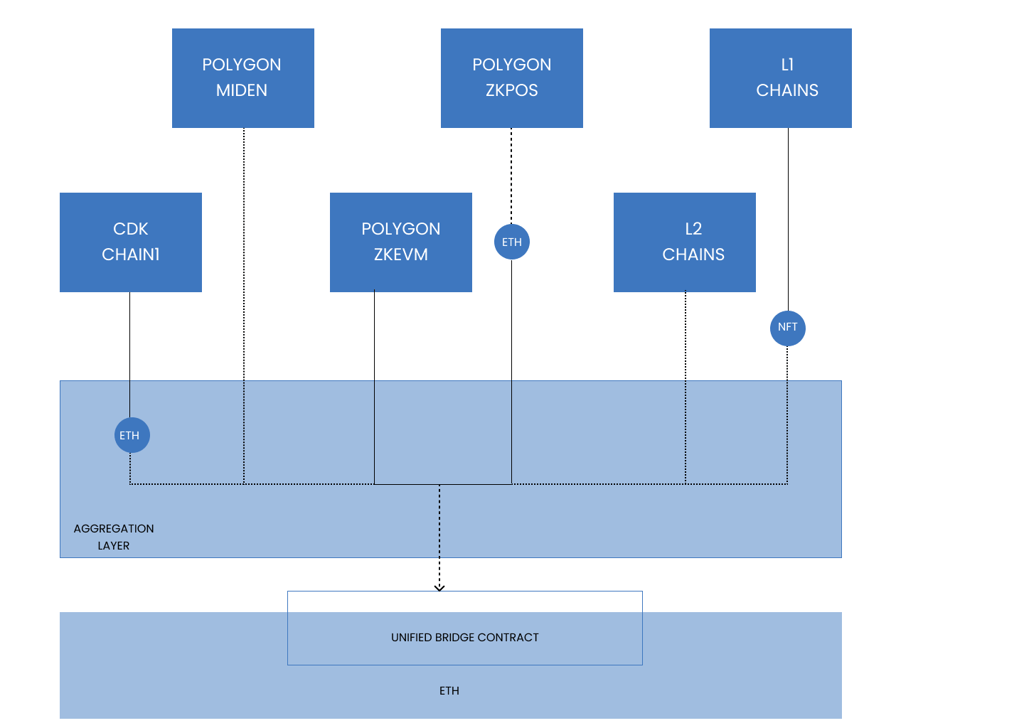At one end of the spectrum, we have seen some major revolutions brought forward by blockchain technology; however, one cannot deny the fact that in the present context, blockchains are no less than beautiful islands, having a different ecosystem built on top of consensus; obstructing their co-mingling.
Bridges undoubtedly have eased the hassle of interoperability but at a cost, which is security. As per the DeFiLama Report, the Web 3 ecosystem has lost $2.5 B to bridge attacks, which amount to roughly 5% to 10% of the total market cap of the Web 3 ecosystem, which is simply huge. The need of the hour, as a result, is to not just make inter-chain communication possible, but on top of that,it should be simple, secure and transparent. That’s where the Polygon’s Agg Layer is solving bridging gaps in the Web 3 ecosystem.
What is the Polygon’s Agg Layer?
Polygon’s Agg Layer is a decentralized messaging layer that would provide all the events happening across different chains in an easy to validate, cost-effective manner using the ZK-Proofs. The Agg-layer will mirror what Cosmos Hub is doing for the private blockchains but with a trade-off of simplifying the user-experience.
How the Agg-Layer Will Simplify the Interchain Blockchain Operation?
At present, the inter-chain communication is not simplified. For context, you need to lock tokens on the source chain to mint synths on the destination chain to trigger operations. Due to such a flaw, interchain communication leads to a capital inefficiency problem. Now, the Polygon Agg-layer is solving the problem through the use of its messaging protocols. These protocols will trigger seamless interchain communication sans complexity by:
- Providing a shared access to all the Ethereum assets using the Agg Layer messaging bridge. The trade off of such a practice is that all the blockchains or rollup ecosystems participating in this equation will not have to lock the tokens. On the contrary, they will be interconnected through the Agg Layer messaging protocol that will be acting like a watch-tower similar to the one we saw in the Lord of the Rings: Trilogy watching all the activities around Southlands, Gondor, Numenor, Rohan and Arnor. Likewise, the Agg-Layer will look after all the information going around different chains and create a collective ZK-proofs to be relayed back to all the chains on demand to trigger executions. Hence, chains need not have to lock tokens in unsafe bridges and end up like sitting ducks for raids. Rather, they can generate the ZK-proofs and the blockchain ecosystem will trigger an execution without any complexity and all the events will be driven through mathematical cryptographical computation.
- The second trade-off with regards to interchain communication is locking the tokens on the bridges for a specific time period that severely impacts liquidity of the chain. Through the Agg-layer, will simply solve the same and eliminate the need to have wrapped tokens for interchain activities. Thereby, allowing the chains in participation to have full sovereignty on their ecosystem and they can drive the utility of their native tokens directly to trigger value appreciation over time as their ecosystem matures with time and network activity.

Conclusion
The need of the hour is to make the Web 3 ecosystem as simple as the TradFi. For context, when you are wishing to transfer money from one user to another in a Tradfi using UPIs, you do not have to time and again add the user. As a result, the UX is superior in contrast to Web 3, where you have to lock tokens across bridges or connect to different blockchains, or make a preferred choice for the blockchain network for moving the assets. Through the use of the Agg-layer, we are seeing a bigger picture where interchain communication is as simple as sending money through UPI using the dynamic atomic swap settlements built on top of the Zk-Tech. Apparently, when we are looking at 10% of the GDP moving to blockchains, a possibility which is as simple as TradFi but with a trade-off of larger control than TradFi will help make blockchains emerge as the greatest revolution of the time when it comes to building the next gen financial system, which is extremely interoperable, cost-efficient and simple.
Here’s where VE3 plays a pivotal role in this transformation, providing comprehensive solutions and infrastructure that facilitate interoperability, reduce costs, and enhance accessibility, thereby accelerating the realization of a more efficient and inclusive financial ecosystem on the Web 3 paradigm. To know more, explore our innovative digital solutions or contact us directly.


















